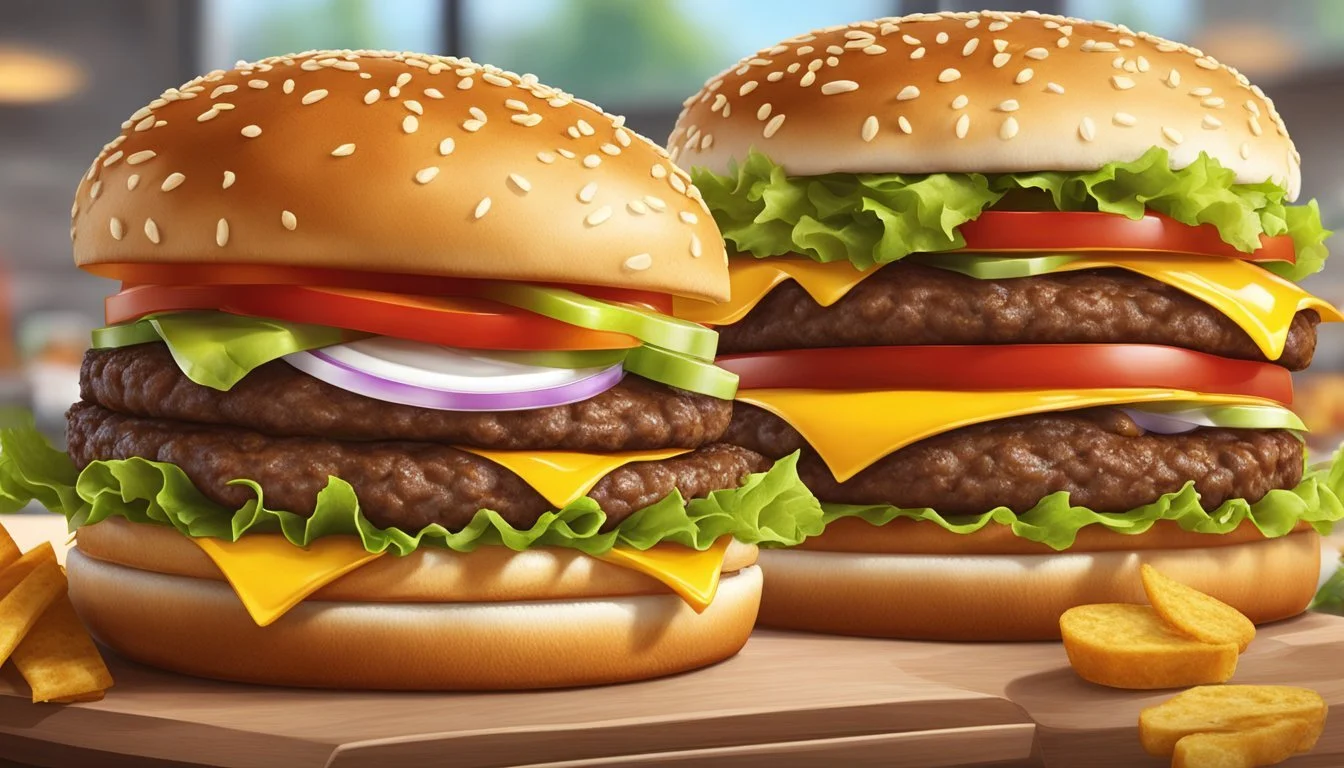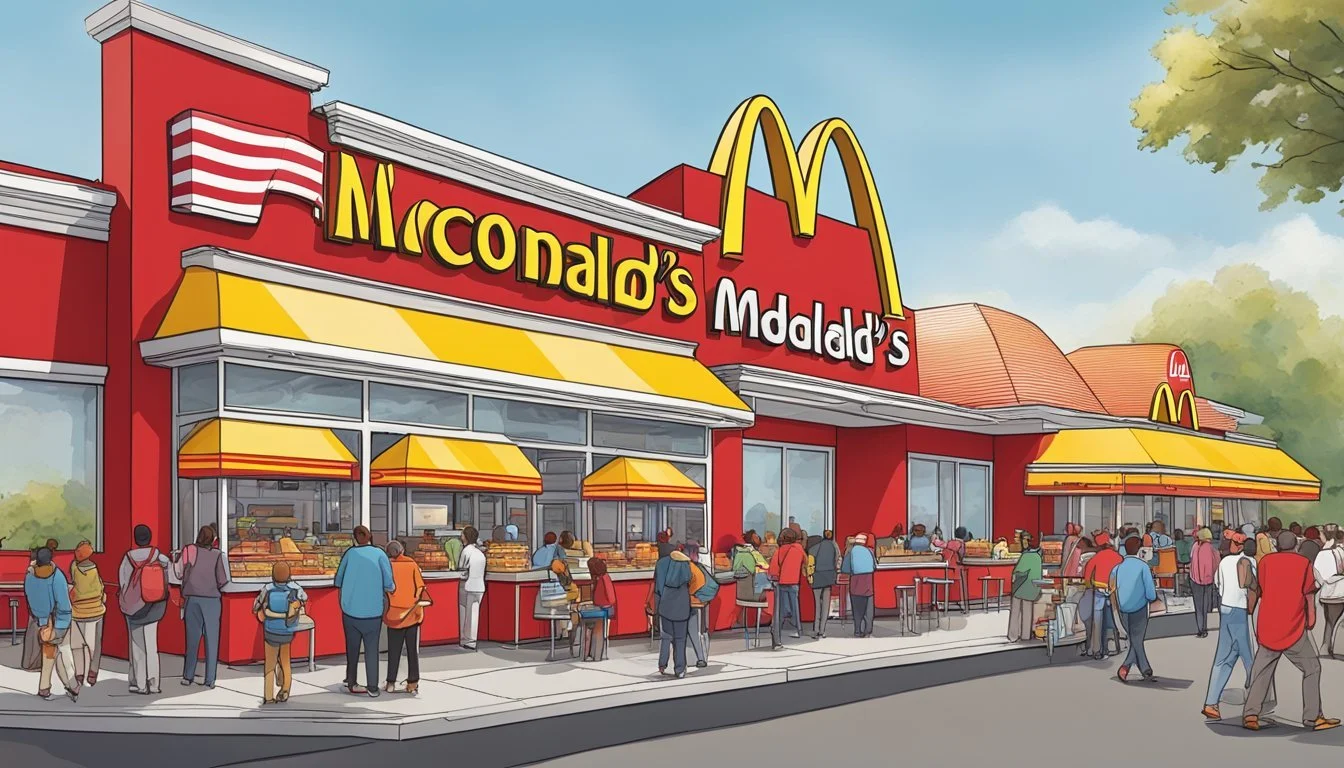McDonald's vs Wendy's
An Unbiased Comparison of Burger Quality and Value
When it comes to fast-food giants, McDonald's and Wendy's stand out in the burger market, each with a distinctive approach to satisfying the quintessential American craving for a quick, hearty meal. Deciding which chain offers the better burger requires a dive into not just the taste and texture of their offerings but also considering factors like nutritional content, value for money, and menu variety. While McDonald's has long enjoyed worldwide dominance with its iconic Big Mac, Wendy's has carved out its own loyal following, championing fresh, never-frozen beef and a unique square patty.
The debate often centers on the quality of ingredients and the overall dining experience. Wendy's markets its burgers as being made with fresh beef, and fans argue that this results in a juicier, more flavorful patty. On the other hand, McDonald's aficionados appreciate the chain’s consistent taste and signature options, from the classic cheeseburger to the more decadent Quarter Pounder. Both chains also constantly evolve their menus, adding new flavors and limited-time offerings to entice and satisfy their customers.
In comparing McDonald's and Wendy's, one may also take into account the caloric and fat content of their signature burgers. The health-conscious consumer might lean towards options that offer a better nutritional profile without compromising on taste. Whether it's Wendy's slightly higher calorie and fat count for a more indulgent burger or McDonald's slightly leaner options, the choice often boils down to personal preference. And while the style of fries might not tip the scales, they often accompany a burger, rounding out the meal and impacting the overall fast-food experience.
Historical Overview
McDonald's, a name synonymous with fast food, was established in 1940 by brothers Richard and Maurice McDonald in San Bernardino, California. The brand saw a revolution in the 1950s under Ray Kroc, who transformed it into a franchise model. As of now, it operates globally with thousands of locations, serving millions of customers daily. Its iconic products include the Big Mac, introduced in 1967, and world-famous fries.
Wendy's entered the fast food arena in 1969 with its founder, Dave Thomas, opening the first restaurant in Columbus, Ohio. Thomas's philosophy centered on providing high-quality, fresh food, with Wendy's distinguishing itself by offering fresh, never frozen beef for their burgers.
Here is a brief comparison:
McDonald's
Founding Year: 1940
Founder(s): Richard and Maurice McDonald
Innovation: Speedee Service System, Big Mac
Global Reach: Over 100 countries with 38,000+ outlets
Wendy's
Founding Year: 1969
Founder(s): Dave Thomas
Innovation: Fresh beef, square patties
Global Reach: Over 6,700 locations in 30 countries
Both chains led notable advertising campaigns over the years, with McDonald's recognized for its "Golden Arches" and Wendy's for the catchphrase "Where's the beef?" from 1984. Despite different origins, McDonald's and Wendy's have become prominent in the cultural and culinary landscape of fast food, emphasizing convenience, flavor, and innovation.
Brand Identity and Positioning
In the competitive landscape of fast-food burger joints, McDonald's and Wendy's distinguish themselves through distinctive brand identities and strategic positioning. Each chain leverages its own unique elements to connect with customers and create market differentiation.
Logo and Branding
McDonald's is immediately recognizable by its iconic golden arches, a symbol of convenience and global reach. This yellow M is not only synonymous with fast-food but has also become a cultural icon, reflecting a consistent and standardized brand experience across more than 120 countries.
Wendy's, on the other hand, features a logo that depicts an image of the namesake of the brand, Wendy Thomas, daughter of the founder Dave Thomas. With her red pigtails and blue-stripe dress, the logo conveys a sense of warmth and homeliness. It aligns with Wendy's brand strategy to present a more "old-fashioned" and quality-oriented image, with items like the square-shaped burgers and the unique Dave's Single reinforcing this identity.
Mission Statement and Values
McDonald's mission is focused on becoming customers' favorite place to eat and drink by providing a modern, progressive burger company delivering a customer-focused experience. They emphasize on values such as quality, service, cleanliness, and value. Over the years, they have sustained growth by continuously innovating their menu and service to align with evolving consumer needs and preferences.
In contrast, Wendy's prides itself on its commitment to quality, its fresh, never frozen beef, and an ethos of doing the right thing. The company's mission highlights offering the best in terms of quality, menu variety, and customers' dining experience. Wendy's values the idea of being 'a cut above' in the fast-food industry, which is reflected in its push for higher quality food products and the drive to keep expanding the brand's reach while maintaining its commitment to quality.
Menu Comparison
When comparing McDonald's and Wendy's, one will find that each boasts a unique selection of items that cater to varied tastes and preferences. They both strive to satisfy classic burger cravings as well as offer distinctive signature items.
Burger Varieties
McDonald's is well-known for its Big Mac, a burger famous for its special sauce and layered buns. They also offer the Quarter Pounder, which is notable for its 100% beef patty. Generally, their burgers tend to be uniform in shape and size.
Wendy's, on the other hand, differentiates itself with its square-shaped beef patties. Notable burger options here include Dave's Single, which features a quarter-pound of beef. Wendy’s emphasizes the freshness of their ingredients, often marketing that their beef is never frozen.
Signature Dishes
McDonald's has made a lasting mark with offerings like the Big Mac and its chicken nuggets, a favorite among customers of all ages. Breakfast menu options, such as the Egg McMuffin, have also gained a large following, contributing to McDonald's reputation as an all-day dining option.
Wendy's brings its Baconator to the forefront, appealing to bacon lovers with a hefty serving of bacon atop a half-pound of beef. Their Frosty, a thick ice-cream-like dessert, stands as a signature dessert item, often enjoyed with their seasoned fries.
Sides and Desserts
McDonald's offers a variety of sides, including world-famous fries, salad options, and apple slices for a healthier choice. Their dessert menu includes items like Apple Pies and the McFlurry, a soft-serve ice cream mixed with various toppings.
Wendy's sides include their natural-cut fries sprinkled with sea salt and a range of salads to complement their main dishes. For dessert, the Frosty is a standout item, available in chocolate or vanilla flavors, and has become a beloved pairing with their fries.
Ingredient Quality
When comparing the ingredient quality of McDonald's and Wendy's burgers, consumers generally focus on the sourcing and freshness of the beef and toppings, as well as the nutritional value such as calorie content and protein levels.
Sourcing and Freshness
Wendy's is known for their never-frozen beef, suggesting a commitment to freshness. They stress that their square beef patties come from fresh, never-frozen beef, something that appeals to consumers looking for a fresher taste. McDonald's, while offering fresh beef in their quarter pounder burgers, generally does not emphasize never-frozen beef across all their burger selections.
Toppings like lettuce and tomatoes are another critical factor for freshness. Wendy's claims that their tomatoes are generally fresher, which enhances the overall taste and quality of their burgers.
Nutritional Value
In terms of nutritional content, both burger joints provide information on calories and protein, allowing customers to make informed choices. For instance:
A typical Wendy's burger may have an additional 40 calories and 7 grams of fat compared to a McDonald's equivalent.
However, customers concerned with protein intake can note that both establishments' burgers are relatively comparable, with slight variations depending on the specific burger.
Freshness and nutritional value significantly influence customer perceptions of ingredient quality at fast food burger restaurants. Wendy's distinct emphasis on never-frozen beef and fresh toppings sets a certain expectation for quality which is reflected in their branding and marketing strategies. McDonald's, with a varied menu, also competes by offering fresh beef in select burgers and providing nutritional information to allow for transparency and informed customer decisions.
Tasting Experience
When deciding which burger is superior, the tasting experience is pivotal, from the subtleties of flavor profiles to the satisfaction of texture and adherence to quality as reflected in popular opinions.
Flavor Profiles
McDonald's and Wendy's offer distinct flavor profiles. McDonald's signature burgers often feature a combination of ketchup, mustard, and pickles, alongside a slice of American cheese. On the other hand, Wendy's burgers are known for their never-frozen beef patties, which are seasoned with more salt to enhance the meat’s flavor. Wendy's also uses mayo and red onions, adding layers of taste that resonate with freshness.
Texture and Consistency
The texture of the burger patties from both chains has a substantial impact on the overall eating experience. McDonald's burgers tend to have a soft and uniform consistency, with each bite providing a blend of their thin yet flavorful patties and the melt of the cheese. Conversely, Wendy's burgers are characterized by a thicker patty, which provides a more satisfying chew, asserting their commitment to a fresher taste.
Popular Opinion and Reviews
According to several taste tests and customer reviews, Wendy's burgers consistently receive praise for the freshness of their toppings and beef patties. Customers frequently note the crispness of the lettuce and the tangy snap of the pickles, contrasting with McDonald's where the emphasis often lies in the familiar taste profile rather than ingredient freshness. McDonald's, however, maintains a loyal fanbase that finds comfort and nostalgia in their classic burger taste.
Customer Experience
When comparing McDonald's and Wendy's, customer experience plays a significant role, with patrons valuing service speed, staff friendliness, and restaurant cleanliness above many other factors.
Service Speed
McDonald's is known for its efficient service, particularly through its drive-thru operations. The chain has honed a system that emphasizes speed and consistency, minimizing the customer's wait time. Wendy's also offers a comparable fast-food experience, striving to maintain quick service, especially during peak hours. Both establishments regularly update their service protocols to ensure they meet the fast-paced demands of their customers.
Staff Friendliness
The customer service ethos at Wendy's often receives praise for staff friendliness and a welcoming atmosphere. Employees are generally seen as courteous and responsive to customer needs. Similarly, McDonald's places a high value on customer interaction, training employees to offer a polite and professional service, though experiences can vary from location to location.
Restaurant Cleanliness
Cleanliness is a cornerstone of the fast-food experience, and both McDonald's and Wendy's recognize the importance of maintaining a clean dining environment. McDonald's implements strict cleanliness standards in both its kitchens and dining areas. Wendy's also attaches significant importance to the tidiness of its restaurants, understanding that a clean space makes for a more pleasant dining experience. Regular inspections and customer feedback systems are in place to uphold these standards.
Pricing and Value
In assessing the better burger joint between McDonald's and Wendy's, pricing structure and the value derived from meals are pivotal considerations for consumers.
Menu Prices
McDonald's showcases an array of options starting at economic prices, with the hamburger priced at $1.69. On the higher end, indulgences like the Double Quarter Pounder with bacon and cheese ascend to $8. Wendy's maintains a competitive edge with items such as the Jr. Cheeseburger Deluxe at a mere $0.99. However, notable offerings like the Baconator and Spicy Chicken Sandwich stand at $6.29 and $4.39, respectively, showcasing their premium positioning in the market.
McDonald's
Hamburger: $1.69
Double Quarter Pounder with Cheese: $8.00
Wendy's
Baconator: $6.29
Spicy Chicken Sandwich: $4.39
Jr. Cheeseburger Deluxe: $0.99
Value Meals and Offers
Both establishments provide value meals, but Wendy's answers consumers' quest for variety and cost-effectiveness with the Biggie Bag—a bundle including a bacon double stack burger, medium fries, a medium drink, and a four-piece chicken nugget. McDonald's, on the other hand, appeals to breakfast-seekers with the Sausage McMuffin with Egg, ensuring a filling meal for under $3. These value meals shine light on the brands' strategies to offer filling options while catering to budget-conscious patrons.
Value and cost are judiciously considered by both companies, as illustrated by their dollar menus and special offers—traditional methods to combat inflation and retain customer loyalty through affordable yet satisfying options.
Brand Diverse Offerings
In the competitive fast-food landscape, McDonald's and Wendy's differentiate themselves through diverse menu offerings that cater to a broad range of preferences and dining occasions, from breakfast to limited-time promotions.
Limited-Time Offers
McDonald's frequently updates its menu with limited-time offers to keep customers engaged and entice them to visit more often. A notable offering is the popular Maple BBQ and Bacon Quarter Pounder which periodically makes a comeback, providing a seasonal twist to the standard burger lineup. On the other hand, Wendy's places its bets on simple, yet high-quality items, opting for less frequent but carefully curated limited-time promotions.
Breakfast and Non-Burger Items
Each chain has its own approach to breakfast. McDonald's boasts a value-oriented breakfast menu, anchored by items like the Sausage McMuffin with Egg, offered for under $3, which is not only affordable but also a robust meal to start the day. In contrast, Wendy's breakfast offerings tend to fetch a higher price, indicating a premium position for its morning fare. Beyond burgers, both chains offer a variety of other items, including salads. They aim to provide options for those seeking lighter or more varied meals, with McDonald’s offering a range of salads like the Southwest Grilled Chicken Salad, while Wendy’s also maintains a selection of fresh salad options.
Innovation and Market Adaptation
McDonald's and Wendy's are constantly evolving in the competitive fast-food landscape to meet dynamic market demands. Their strategies focus on improving customer experience through technological advancements and adapting their menu to reflect health trends.
Technology and Ordering Systems
McDonald's has leveraged technology to enhance sales and streamline customer service. They have implemented self-service kiosks and a mobile app for convenient ordering. This has helped reduce wait times and improved order accuracy, leading to an increase in customer satisfaction. Their global sales have benefited from these innovations, positioning McDonald's as a leader in fast-food tech.
Wendy's, while smaller than McDonald's, still competes effectively by focusing on quality ingredients and customer experience. They have also embraced technology, offering mobile ordering and payment options, but their main selling point remains their commitment to fresh, never frozen beef.
Adaptation to Health Trends
Both chains have adapted their menus in response to the growing consumer interest in healthier options. Here's how:
McDonald's:
They introduced salads, fruit options, and have made efforts to create a more balanced menu.
Calorie counts are now displayed, becoming a standard practice that promotes transparency for health-conscious consumers.
Wendy's:
They offer their own variety of salads and have marketed themselves as using fresh ingredients.
The focus on quality extends to their burgers, with Wendy's emphasizing the use of fresh, not frozen, beef to appeal to those looking for a healthier burger option.
Both chains are finding ways to maintain relevance and meet the specifications of a diverse consumer base while recognizing competitors like Burger King, which continues to attract customers with its signature Whopper.
Environmental and Social Responsibility
In the competition between fast-food burger giants, McDonald’s and Wendy’s both prioritize environmental and sustainability efforts, as well as community engagement, recognizing these as essential to their long-term success and image.
Sustainable Practices
McDonald's established itself as a leader in environmental responsibility among fast-food chains by setting a science-based target to reduce its greenhouse gas emissions by 2030. Wendy’s also has shown commitment to sustainability by implementing energy-saving measures and seeking to reduce its overall energy footprint.
McDonald's:
Commitment to a science-based target to reduce emissions.
Sustainable packaging and waste reduction initiatives.
Wendy's:
Energy efficiency programs.
Sourcing of food products that adhere to environmental standards.
Community Engagement
The brainchild of the fast-food industry pioneers, community engagement programs are instrumental for both McDonald's and Wendy's. They have taken distinct, yet substantial, actions to nourish and support the communities they operate within.
McDonald's:
Focus on feeding and fostering communities.
Corporate social responsibility (CSR) early adoption.
Wendy's:
Emphasis on quality ingredients and fresh produce.
Corporate initiatives to support employee and community well-being.
Summary and Conclusion
Both McDonald's and Wendy's offer unique dining experiences with distinctive offerings that cater to diverse customer preferences.
Final Verdict
McDonald's boasts a vast global presence, a variety of menu options, and the iconic Big Mac. Its franchise model with a lower liquidity requirement allows greater expansion, possibly leading to more location convenience for customers. Wendy's, characterized by its fresh ingredients and square-shaped burgers, provides a smaller but potentially more curated dining experience. Its Frosty dessert is a signature item not mirrored at McDonald's.
When comparing nutritional content, McDonald's hamburgers contain higher levels of certain nutrients such as Selenium and Calcium. However, Wendy’s burgers contain significantly more Vitamin B12 and less Calcium. The caloric and fat content of the burgers also differ, with Wendy’s usually offering slightly higher amounts than McDonald’s.
Future Outlook
Both chains continue to innovate with menu options and customer experiences. McDonald's return of the Maple BBQ and Bacon Quarter Pounder hints at its strategy to bring back popular limited-time offers to entice customers. Meanwhile, Wendy’s maintains a focus on simpler menu changes that emphasize fresh ingredients. The evolution of these fast-food giants will likely be shaped by consumer trends towards convenience, quality, nutrition, and ethical business practices.









